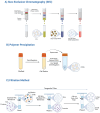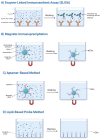Extracellular vesicles: from intracellular trafficking molecules to fully fortified delivery vehicles for cancer therapeutics
- PMID: 39823046
- PMCID: PMC11733735
- DOI: 10.1039/d4na00393d
Extracellular vesicles: from intracellular trafficking molecules to fully fortified delivery vehicles for cancer therapeutics
Abstract
Extracellular vesicles (EVs) are emerging as viable tools in cancer treatment due to their ability to carry a wide range of theranostic activities. This review summarizes different forms of EVs such as exosomes, microvesicles, apoptotic bodies, and oncosomes. It also sheds the light onto isolation methodologies, characterization techniques and therapeutic applications of all discussed EVs. Evidence indicates that EVs are particularly effective in delivering chemotherapeutic medications, and immunomodulatory agents. However, the advancement of EV-based therapies into clinical practice is hindered by challenges including EVs heterogeneity, cargo loading efficiency, and in vivo stability. Overall, EVs have the potential to change cancer therapeutic paradigms. Continued research and development activities are critical for improving EV-based medications and increasing their therapeutic impact.
This journal is © The Royal Society of Chemistry.
Conflict of interest statement
There are no conflicts to declare.
Figures





Similar articles
-
Translating extracellular vesicle packaging into therapeutic applications.Front Immunol. 2022 Aug 15;13:946422. doi: 10.3389/fimmu.2022.946422. eCollection 2022. Front Immunol. 2022. PMID: 36045692 Free PMC article. Review.
-
Production of Extracellular Vesicles Loaded with Therapeutic Cargo.Methods Mol Biol. 2018;1831:37-47. doi: 10.1007/978-1-4939-8661-3_4. Methods Mol Biol. 2018. PMID: 30051423 Free PMC article.
-
Extracellular vesicles in cancers: mechanisms, biomarkers, and therapeutic strategies.MedComm (2020). 2024 Nov 28;5(12):e70009. doi: 10.1002/mco2.70009. eCollection 2024 Dec. MedComm (2020). 2024. PMID: 39611045 Free PMC article. Review.
-
Bioengineered extracellular vesicles: The path to precision medicine in liver diseases.Liver Res. 2025 Feb 20;9(1):17-28. doi: 10.1016/j.livres.2025.02.002. eCollection 2025 Mar. Liver Res. 2025. PMID: 40206438 Free PMC article. Review.
-
Extracellular vesicles and their therapeutic applications: a review article (part1).Int J Physiol Pathophysiol Pharmacol. 2024 Feb 25;16(1):1-9. doi: 10.62347/QPAG5693. eCollection 2024. Int J Physiol Pathophysiol Pharmacol. 2024. PMID: 38618492 Free PMC article. Review.
Cited by
-
Extracellular vesicles aid in the transfer of long-term associative memory between Caenorhabditis elegans.bioRxiv [Preprint]. 2025 Jun 13:2025.02.26.640282. doi: 10.1101/2025.02.26.640282. bioRxiv. 2025. PMID: 40661426 Free PMC article. Preprint.
-
Proteomics of Extracellular Vesicles: Recent Updates, Challenges and Limitations.Proteomes. 2025 Mar 4;13(1):12. doi: 10.3390/proteomes13010012. Proteomes. 2025. PMID: 40137841 Free PMC article. Review.
-
Loading of Enzymatic Cargos into Extracellular Vesicles Derived from Lung Cancer Cells.Int J Nanomedicine. 2025 Aug 15;20:9931-9944. doi: 10.2147/IJN.S528193. eCollection 2025. Int J Nanomedicine. 2025. PMID: 40837695 Free PMC article.
-
Enhancing Wound Healing Through Secretome-Loaded 3D-Printed Biomaterials.Gels. 2025 Jun 20;11(7):476. doi: 10.3390/gels11070476. Gels. 2025. PMID: 40710638 Free PMC article. Review.
-
Pharmacological Agent GW4869 Inhibits Tick-Borne Langat Virus Replication to Affect Extracellular Vesicles Secretion.Viruses. 2025 Jul 10;17(7):969. doi: 10.3390/v17070969. Viruses. 2025. PMID: 40733586 Free PMC article.
References
Publication types
LinkOut - more resources
Full Text Sources

